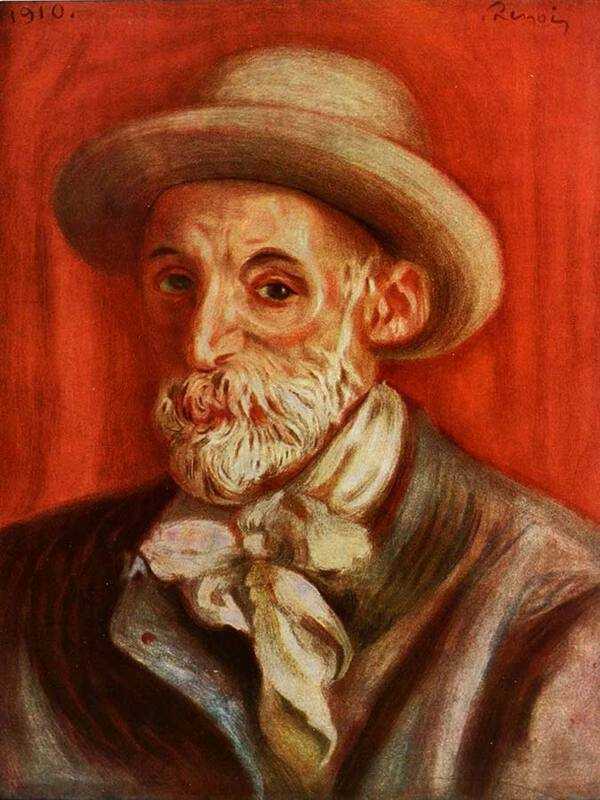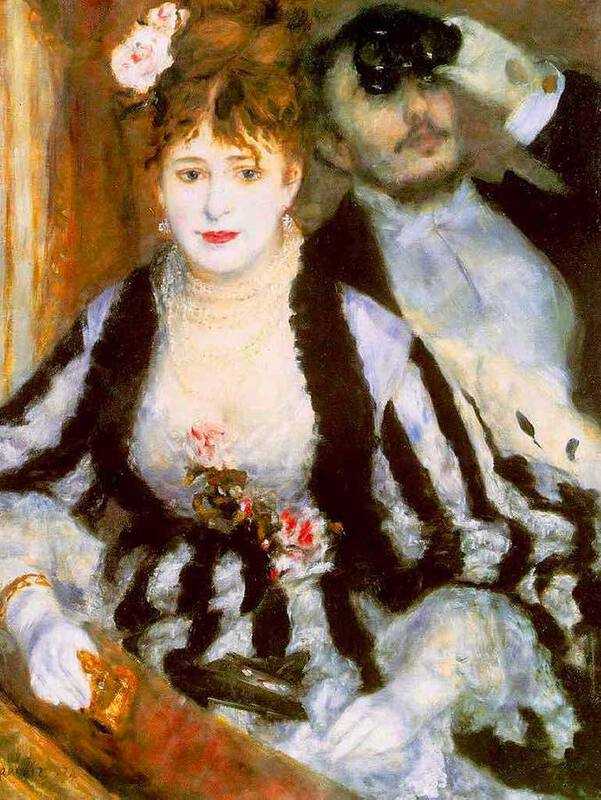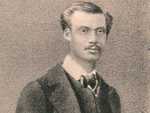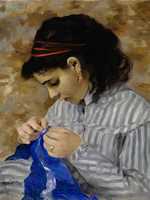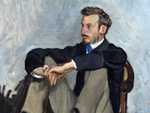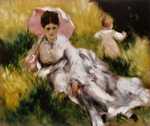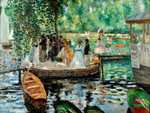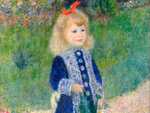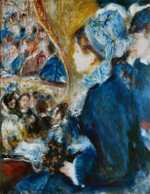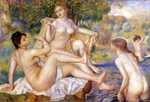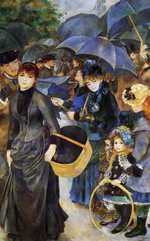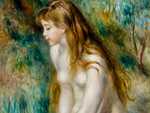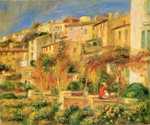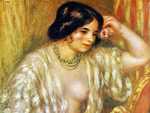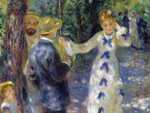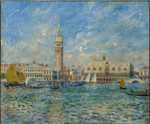1. Renoir's early years
Pierre-Auguste Renoir was born on 25 February 1841 in Limoges, the sixth of seven children.
His father, Leonard, was a tailor; his mother a seamstress. One of Renoir’s earliest memories was watching his father sitting cross-legged on the floor surrounded by cloth, scissors, patterns and velvet pincushions. He also regularly drew on the floor with his father’s chalk.
Paris and porcelain
Renoir and his family moved to Paris when Renoir was three, his father seeking to enhance his prospects. After seven years in a catholic primary school, aged just 13, Renoir became an apprentice porcelain painter.
Renoir’s work involved painting flowers, pastoral scenes and even the portrait of Marie Antoinette onto cups, vases and plates. He excelled and developed a love of the bright luminous painting for which he was to become famous.
Interesting fact...
Renoir obviously had a prodigious natural talent, and was able to paint far quicker than his fellow artisans (who named him Monsieur Rubens). This meant that he earned good money, for he was paid by the piece, and he was able to help his parents buy a little cottage in Louveciennes.
Renoir took evening classes in painting and often spent his lunch hour sketching at the Louvre. But this happy life was halted by the industrial revolution: a machine was invented to print pictures onto china and he and his colleagues were made redundant. He therefore turned to painting fans and banners.
Renoir studies art
By the age of 21, Renoir has saved enough to further his further studies.
He enrolled at the Ecole des Beaux-Arts (though this was short-loved as he didn’t enjoy its rigid syllabus) and took evening courses at Gleyre’s studio. It was here that he met Claude Monet, Alfred Sisley and Frederic Bazille.
Not that Renoir always got on with Gleyre. On one occasion, Gleyre said to Renoir “Young man, you are very skilful, but it looks like you only paint for your own enjoyment”, to which Renoir replied
“well yes, if I didn’t enjoy it I wouldn’t be doing it”.
Unlike many of the other impressionists, Renoir was easy-going and tolerant. He was not trying to be disrespectful. He just had a passion for painting.
2. The early impressionist years
The early years of Renoir's career were difficult: he had to scrimp and save; he had mixed fortunes at the Salon; and he was distracted by three stints in the army.
Living with the other impressionists
To economise, Renoir shared lodgings with Monet in the early 1860s and subsisted on a diet of beans and lentils (a sack of beans lasted for a month, when they changed to lentils, and so on). Monet occasionally managed to get them an invitation to dinner, where they made sure to gorge themselves.
Renoir was still able to make some money by decorating porcelain and painting portraits of tradesmen.
Interesting fact...
Renoir and Monet just about made ends meet, though Monet never paid his tailor. When the poor man complained, Monet threatened to take his custom elsewhere. As Renoir remarked, Monet was a “born lord”.
Renoir moved into Sisley’s studio in 1865 and went sailing with him down the Seine. He moved in with Bazille the next year when Sisley got married.
The Cafe Guerbois and Fontainebleau
In 1863, Manet shocked the conservative art world with his painting Dejuner Sur l'Herbe (Lunch on the Grass).
Thereafter, Manet became the inspiration for the artists looking to move away from classical art. They started to meet at the Cafe Guerbois, together with writers sympathetic to their ideas, to discuss art, politics and their lives.
Over the years a group coalesced. Its artist members included Manet, Renoir, Monet, Degas, Pissarro, Cezanne, Sisley and Bazille. Another prominent member of the group was writer, and close childhood friend of Cezanne, Emile Zola.
In the spring of 1863, Monet organised a trip to Fontainebleau to paint the landscape. The 62,000-acre Fontainebleau forest, about 30 miles from Paris, is full of pretty crags and had become a popular destination for those day-tripping from the capital. Though Renoir was predominantly a portraitist, he went along anyway.
It was here that Renoir met the Barbizon school painter Narcisse Diaz. The two struck up a friendship, perhaps grounded in the fact that they had both painted porcelain. Diaz encouraged Renoir to lighten his palette and provided him with free paintings materials.
The Salon
Renoir was accepted by the Salon of the Academy des Beaux Arts on his first try in 1864. This was important: the Salon was the premier exhibition of the time and the place at which aspiring artists could show their work to the buying public and art critics.
Interesting fact...
Renoir's painting was the intriguingly named Esmeralda Dancing with a Goat. But Renoir destroyed the painting after it was exhibited, because it had been ignored by reviewers.
The latter part of the decade was a mixed time for Renoir's Salon submissions: he was rejected in 1866 and again in 1867 (even though his painting,Diana, made a number of concessions to please the traditionalists); but the 1868 jury accepted his full-length portrait of his muse and model Lise Trehot, which attracted positive reviews for its bold brushwork.
The Frogpond
One of Renoir's major works from this period is The Frogpond, or Le Grenouille, painted in 1869. At the time, 'frog' was slang for young woman.
The Frogpond was a popular spot on the Seine frequented by Parisian day trippers. Renoir and Monet painted side-by-side and, no doubt influenced by each other, produced very similar canvasses.
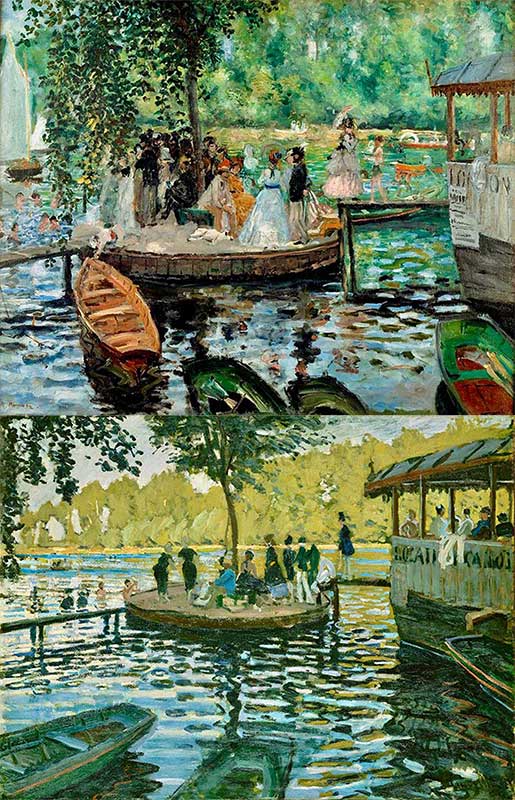
Military service and the Franco-Prussian War
Renoir’s plans were disrupted in 1862 and again in 1864 when he underwent two stints of military service. Taking up four months in all, Renoir lacked the means to buy his way out of military service by paying for a substitute.
In 1870, Emperor Napoleon III contrived to declare war on the Prussians following a series of political miscalculations. The war and the ensuing Siege of Paris, which took place over the winter of 1870/1, involved a number of the impressionists in different ways.
Interesting fact...
Renoir was conscripted into the army, assigned to a cavalry unit in southern France (even though he knew nothing about horses), saw no fighting and caught dysentery. In some ways he was lucky: Bazille was killed in a battle; and Manet joined the army and defended Paris during the 131-day Siege of Paris.
Others were less patriotic: Cezanne hid out in Provence; and Monet moved to London with his new wife and young child.
Monet's time in London was important for the impressionist movement: it was here that he met Paul Durand-Ruel, the gallery owner who became the impressionists' most important supporter.
3. Renoir comes of age: 1873-1882
Renoir came of age in the decade following the Prussian war.
He sold works to collectors and painted some of his most enduring works, including La Loge (the Theatre Box), Ball at the Moulin de la Galette and Luncheon at the Boating Lake.
Durand-Ruel and Salon rejections
Renoir returned to Paris in June 1871, along with the rest of the impressionists.
Perhaps the only positive to come out of the Prussian War was the friendship Monet formed with Paul Durand-Ruel whilst in London.
Interesting fact...
Durand-Ruel was an art dealer with galleries in London and Paris. And, as soon as Monet introduced Renoir to him, Durand-Ruel purchased two of Renoir's works: a still life of flowers and a painting of a Parisian bridge, for a total of 600 francs.
The next years were full of ups and downs. Durand-Ruel continued to purchase paintings, and Renoir was able to attract other collectors (including Henri Rouart and Theodore Duret); but he was rejected by the Salon in 1872 and 1873; and Lise Trehot, his girlfriend of seven years, dumped him and married an architect.
The end of 1873 brought a new low. An industrial crisis placed Durand-Ruel in severe financial difficulties and he suspended payments to the impressionists.
1874: the first impressionist exhibition
The economic outlook spurred the impressionists into action. They founded the Societe Anonyme des Artistes, Peintres, Sculpteurs et Greveurs and put on their own exhibition on the Boulevard des Capucines.
Renoir was centrally involved: he decided how the paintings should be hung, with his brother Edmond in charge of the exhibition catalogue.
Interesting fact...
Monet submitted a number of paintings to the first impressionist exhibition. But the titles he gave them were uninspired. So Renoir's brother decided to call one of them Impression: Sunrise. This is the origin of the term 'impressionism', first used as an insult by hostile reviewers and later adopted by the group.
Renoir displayed six oil works and one pastel. The reviews were overwhelmingly negative, with The Dancer singled out for particular abuse. Leroy said that the dancer's legs were:
"as cottony as the gauze of her skirts".
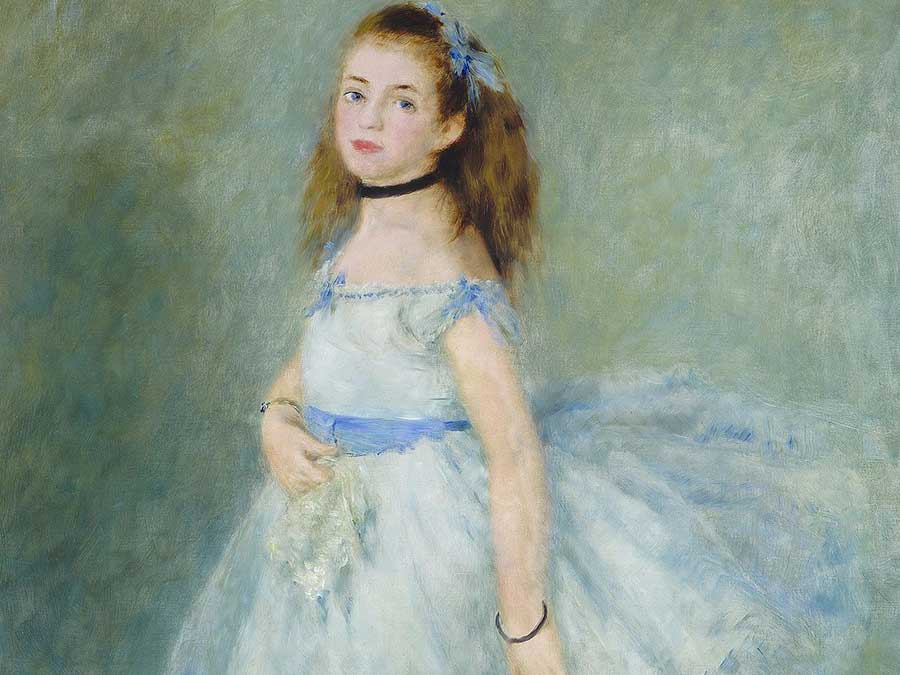
But he didn't understand: Renoir and his friends were not trying to produce a photographic effect; they were trying to reproduce the impression that a scene left on them.
Another of Renoir's submissions to the first exhibition was La Loge (or The Theatre Box). This work is now rightly regarded as one of the gems of the impressionist period.

It features Renoir's brother Edmond and a model, Nini Lopez, known as "fishface". Nini, the main subject of the painting, is scanning the audience but is also aware that she is being watched.
1876: the second impressionist exhibition
Renoir took part in the second impressionist exhibition, held two years after the first, exhibiting 15 paintings. They included 12 portraits. Renoir was not the main target of vicious attacks by critics, though Albert Wolff took aim at his painting Study: Torso, Effects of Sunlight.
One of Caillebotte's eight paintings, The Floor Strippers, stole the show. But, overall, the exhibition was not a success. Albert Wolff's acidic review observed that:
"Rue Le Peletier [where the exhibition was held] is unlucky. After the fire at the Opera, here is a new disaster befalling the district. ..."
1877: the third impressionist exhibition
The third impressionist exhibition followed the next year. Renoir contributed 21 paintings, about 10% of the total number shown. They included one of his most important works, Ball at the Moulin de la Galette.
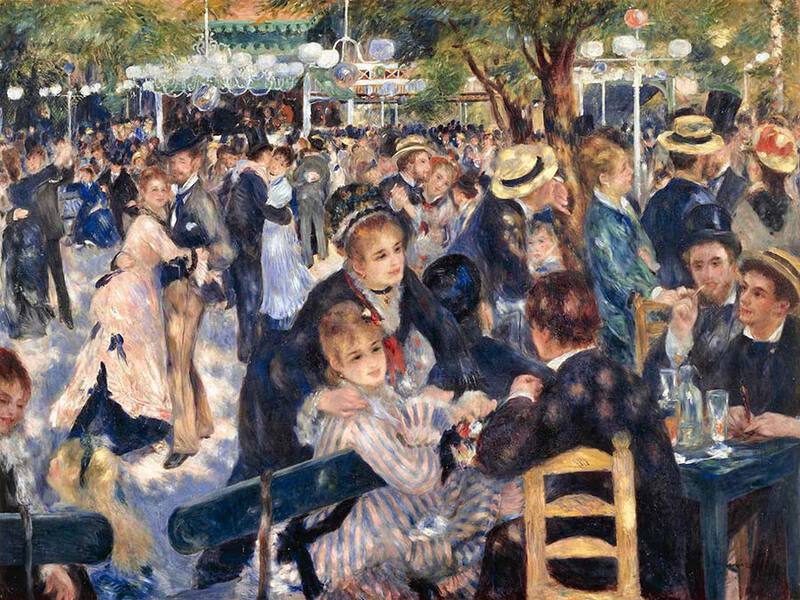
This painting of a Parisian windmill converted into a bar and dancehall is about pure joy: young people dressed in the latest fashions are flirting, dancing and generally having fun.
Interesting fact...
Ball at the Moulin de la Galette is the second most expensive impressionist work ever sold, fetching $78 million when auctioned in 1990 (giving it an adjusted price of $187.8 million).
But the critics could not resist laying into Renoir. Wolff was again the chief culprit, remarking of one of Renoir's paintings:
"So many studies done at the morgue to reach such a result"
1878-9: Salon success
By early 1878, Renoir had had enough of the hostile reviews. Unlike Manet and Cezanne, he was not independently wealthy and so had to earn a living.
Renoir did have a work accepted at the Salon that year, The Cup of Chocolate, but it failed to attract any real attention. The next year, he opted out of the fourth impressionist exhibition and had another work accepted by the Salon.
This time he made much more of a mark. His painting, Madame Charpentier and her Children, depicts a wealthy socialite and her family. The success had much to do with the social standing of Madame Charpentier and the fact that Renoir downplayed his impressionist style.
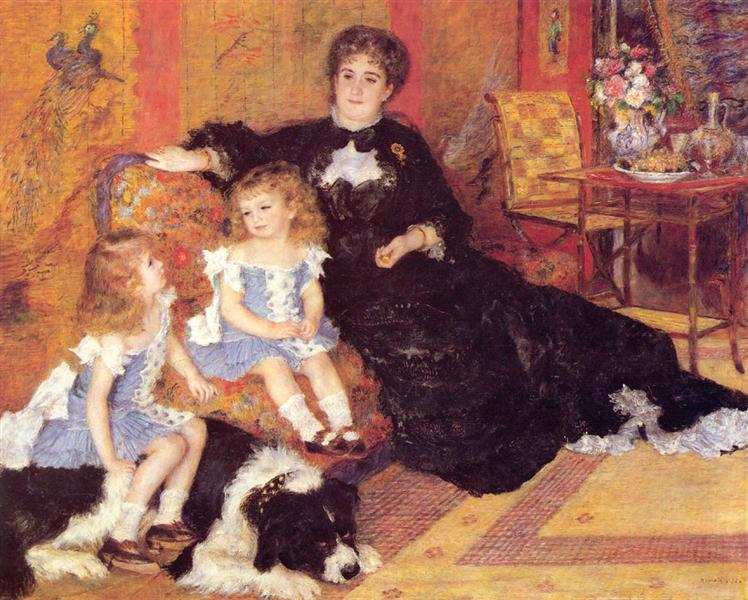
A one-man show followed in July 1879. But normal service was resumed in 1880: though Renoir's paintings were again accepted by the Salon, they did not receive much attention.
At least Renoir's improved status as a well-known portraitist ensured a regular supply of lucrative commissions.
1880-1: Lunch at the Boating Lake
Last but not least comes Lunch at the Boating Lake, perhaps Renoir's most famous work.
Renoir and his girlfriend and later wife Aline courted at the Hotel Fournaise. Renoir chose an outdoor terrace to paint this picture of people having fun on a Sunday afternoon. The models for the picture include impressionist painters Mary Cassatt and Gustave Caillebotte.
Lunch at the Boating Lake is one of our 10 best impressionist works.
4. Renoir's Dry Period
Renoir travelled to Italy in 1881 and was awe-struck by the Titian and Raphael masterpieces he saw in Florence and Rome.
On his return, he started questioning whether to continue painting in the impressionist style.
Renoir’s so-called Dry Period (also known as his Ingres Period, after the French neo-classical painter) started two years later and lasted until about 1888.
Renoir described his change in emphasis as follows
“Around the year 1883 I had exhausted impressionism and came to the conclusion that I could neither paint nor draw. In short, impressionism had led to a dead end. … An artist who paints straight from nature is really only looking for nothing but momentary effects. He does not try to be creative himself – and as a result the pictures soon become monotonous.”
How did Renoir change?
Renoir’s work over his Dry Period changed in three main ways.
First, he used more precise and detailed brush strokes as well as paler and cooler colours.
Secondly, his dark period paintings are evenly lit and no longer seek to depict the light and shadows that are characteristic of so many of Renoir’s earlier works.
Thirdly, Renoir started using geometry to construct his paintings, in particular spheres. Renoir, like Cezanne (who used cones), became convinced that his paintings needed more structure.
Famous Dry Period paintings
Renoir’s key works from his dry period include:
- The Bathers (1884-7), a painting of three female nudes playing in a pond. To a modern eye, the work is unconvincing, with one of the bathers looking like she has had plastic surgery and had her picture airbrushed.
- The Umbrellas, a striking work given structure by its many unfurled umbrellas, but (save for the small girl in the bottom right) is lacking in charm and intimacy.
The last example of Renoir's Dry Period works are three paintings of couples dancing executed in 1883. The three works show couples at a high-class ball in the city (Dance in the City), in the open air countryside (Dance in the Countryside), and dancing in a small village to the west of Paris called Bougival (Dance at Bougival).
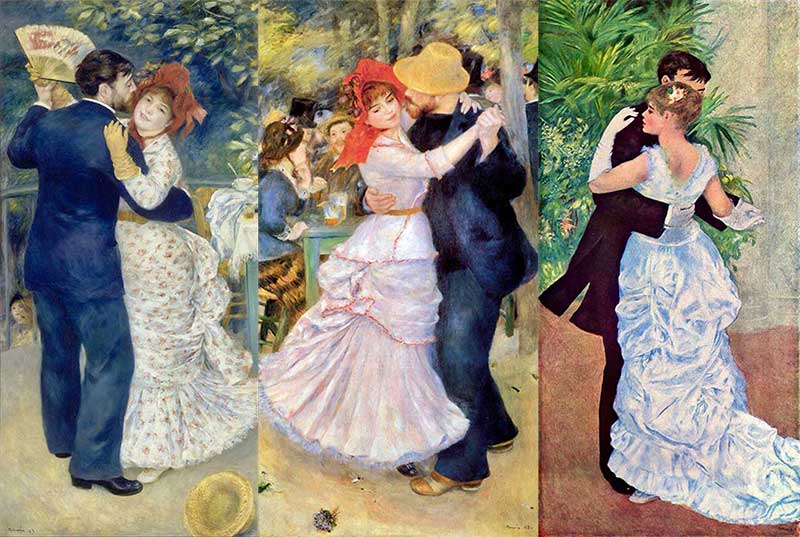
5. Renoir's Later Years
Renoir’s later years were mixed: he suffered from ill-health, but married and had three sons; and he became an acclaimed and rich artist, but arthritis meant that he could barely hold a paintbrush and had to sculpt by giving instructions to an assistant.
Ill-health
In December 1888, Renoir suffered an attack of rheumatoid arthritis and facial paralysis. His arthritis worsened over the subsequent three decades of his life, with Renoir often seeking out the warmth of the Mediterranean sun to ease his symptoms.
A further attack in December 1898 resulted in the paralysis of Renoir’s right arm, with deformation of his hands and arms setting in two years later. 1910 saw the paralysis of Renoir’s legs, and he was thereafter confined to a wheelchair.
Renoir was, however, not one to complain. He was just about able to hold a paintbrush between his bandaged fingers; and he had a special easel made that allowed him to work sitting down.
Sculpture
Renoir turned to sculpture in his later years. He often reproduced his own paintings, such as Mother and Son (a sentimental work of a mother breastfeeding), in clay. Renoir's other notable sculptures include Venus Victorius and The Judgment of Paris.
Interesting fact...
Renoir also developed a close sculpting relationship with French art student Richard Guino – Renoir completed sketches of his sculptures and gave Guino instructions as to how to execute the work.
As Peter Feist explains:
"Renoir would give instructions [to Guino] with a pointer: 'Take a bit off there ... a little more ... that's right! This should be rounder, fuller ...!' The two were so well coordinated that in the end they communicated with each other by means of short noises and exclamations, and a critical or pleased grunt from Renoir was all that was necessary."
Children and marriage
Renoir became a father late in life. His three children, Pierre, Jean and Claude were born in 1885, 1894 and 1901 (when Renoir was 44, 53 and 60 years old respectively).
The mother of Renoir’s children was Aline Charigot, Renoir’s long-term girlfriend (and one of the central characters in Luncheon on the Boating Lake), who he finally married in 1890.
Aline died in 1915, at the age of 56, seemingly weakened as a result of serious injuries sustained by Pierre and Jean during the first world war.
Renoir’s reputation
Public recognition started to come in 1890, when Durand-Ruel held a large exhibition of 110 of his works and Yvonne and Christine Le rolle Playing the Piano was bought by the French state for the Musee du Luxembourg.
The Cross of the Legion d'Honneur followed in 1900, with Renoir made an Officer of the Legion of Honour in 1911.
Interesting fact...
Financial success was also achieved, with businessmen often pleading with Renoir to paint their wives and daughters (and saying that he could name his price)!
Renoir’s later works
Renoir’s later works were a return to his impressionist style, though perhaps with even more vibrant colours. As before, Renoir focused on portraits of girls and women, though he also painted landscapes of the Mediterranean towns he visited to try to ease his arthritis. One difference from the old days was the large number of nudes painted by Renoir.
Renoir’s key works from the last 30 years of his life include Young Girl Bathing (1893, part of MoMA’s permanent exhibition), Terrace in Cagnes (1905, held by Tokyo’s Bridgestone Museum of Art) and Gabrielle with Jewels (1910, privately owned).
Renoir’s death
Renoir died on 3 December 1919, having competed his last large-scale work (Rest after a Bath) and a still life with apples. He had been suffering from pneumonia and working had become extremely painful. He is buried in Essoyes next to Aline.
6. Renoir's Legacy
Renoir, one of the core impressionists, gave the world a substantial body of paintings of pure joy.
Renoir would not have claimed to be the leader of the impressionist movement. That title fell to Manet in the early years and then to Monet and to some extent Pissarro.
Feminine Beauty
Renoir was instead kind, gentle and grateful to be painting works that he found beautiful. It is perhaps for this reason that Renoir predominantly focused on works of women and young girls and, increasingly in his old age, female nudes.
As Renoir said:
"A work of art has to grip the spectator, engulf him, carry him away. The artist communicates his passion with it, it is the current which he radiates, and he uses it to draw the spectator into his passion".
Renoir had a unique ability to catch the female form and expression, be it excitement, diffidence, contemplation or bashfulness.
Interesting fact...
Renoir himself admitted, without embarrassment, that for him the most beautiful part of a female's body was her buttocks. Though, on another occasion, he said that if God had not created breasts he might not have become a painter!
Renoir's most famous works
Renoir's body of work is found in the world's best museums, particularly those of northern Europe and the United States.
Though perhaps not as famous as Monet's Water Lilies or Cezanne's Card Players, those with a little knowledge of art would recognise La Loge (The Theatre Box), the Frogpond, Moulin de la Galette and Luncheon on the Bating Lake. They would probably also recognise Renoir's distinctive colourful and glossy style.
Renoir's paintings have, unsurprisingly, done well at auction. The second most expensive impressionist work is a version of Renoir's Moulin de la Galette, which sold for $78.8 million in 1990, giving it an adjusted price of almost $200 million.
To learn more, check out our page on Renoir's Top 10 Paintings.
Renoir resources
To take your knowledge to the next level, check out our resources page - you'll find recommendations for the best impressionist books, videos and gifts.



